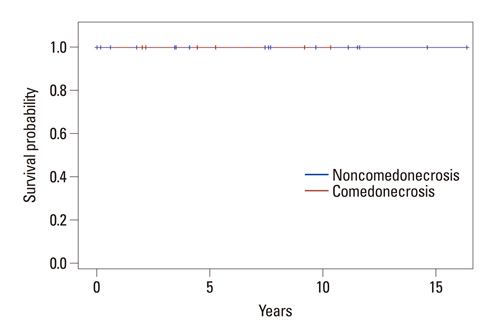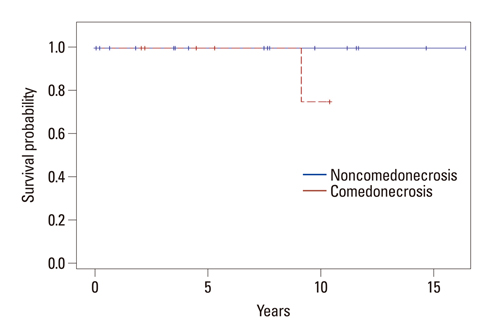Yonsei Med J.
2012 May;53(3):537-542. 10.3349/ymj.2012.53.3.537.
Clinical Outcomes of Ductal Carcinoma In Situ of the Breast Treated with Partial Mastectomy without Adjuvant Radiotherapy
- Affiliations
-
- 1Breast Cancer Center, Department of Surgery, Gangnam Severance Hospital, Yonsei University College of Medicine, Seoul, Korea. hdlee@yuhs.ac
- KMID: 1776988
- DOI: http://doi.org/10.3349/ymj.2012.53.3.537
Abstract
- PURPOSE
Some recent trials suggest that postoperative adjuvant radiotherapy (RT) may be safely omitted after breast-conserving surgery (BCS) for some patients with ductal carcinoma in situ (DCIS). In this study, we reviewed clinical outcomes of patients with DCIS treated with partial mastectomy (PM) without adjuvant RT.
MATERIALS AND METHODS
Medical records of 28 patients (29 breasts) with DCIS who were treated with PM, but without RT, between April 1991 and December 2010 were retrospectively analyzed. Based on established criteria (2.0 cm or less in size and no comedonecrosis), 18 patients were treated without RT after PM. Seven patients (8 breasts) who did not receive RT due to refusal were also included in this study. Three other patients were excluded because data concerning comedonecrosis were not available.
RESULTS
For the 25 patients included in this study, the mean age of the 18 patients who met the criteria was 47.9+/-6.2 years, and 47.6+/-12.7 years for the 7 patients who did not. The mean sizes of the primary tumors were 0.6+/-0.4 cm and 0.9+/-0.3 cm, respectively, in these two groups. Among these 25 patients (26 breasts) treated without RT, we observed no ipsilateral breast tumor recurrence or mortality within a mean follow-up of 84 months.
CONCLUSION
Based on this small number of cases, patients with DCIS, who were selected for tumor size less than 2 cm and absence of comedonecrosis, may be treated successfully with BCS; adjuvant RT may be omitted.
Keyword
MeSH Terms
Figure
Reference
-
1. Ko SS. Korean Breast Cancer Society. Chronological changing patterns of clinical characteristics of Korean breast cancer patients during 10 years (1996-2006) using nationwide breast cancer registration on-line program: biannual update. J Surg Oncol. 2008. 98:318–323.
Article2. Kerlikowske K. Epidemiology of ductal carcinoma in situ. J Natl Cancer Inst Monogr. 2010. 2010:139–141.
Article3. Silverstein MJ, Barth A, Poller DN, Gierson ED, Colburn WJ, Waisman JR, et al. Ten-year results comparing mastectomy to excision and radiation therapy for ductal carcinoma in situ of the breast. Eur J Cancer. 1995. 31A:1425–1427.
Article4. Fisher ER, Dignam J, Tan-Chiu E, Costantino J, Fisher B, Paik S, et al. Pathologic findings from the National Surgical Adjuvant Breast Project (NSABP) eight-year update of Protocol B-17:intraductal carcinoma. Cancer. 1999. 86:429–438.
Article5. Fisher B, Land S, Mamounas E, Dignam J, Fisher ER, Wolmark N. Prevention of invasive breast cancer in women with ductal carcinoma in situ: an update of the National Surgical Adjuvant Breast and Bowel Project experience. Semin Oncol. 2001. 28:400–418.
Article6. Wapnir I, Dignam J, Julian TB, Land S, Mamounas EP, Anderson S, et al. Long-term outcomes after invasive breast tumor recurrence (IBTR) in women with DCIS in NSABP B-17 and B-24. J CLIN ONCOL (MEETING ABSTRACTS). 2007. 25:520. abstr 520.
Article7. EORTC Breast Cancer Cooperative Group. EORTC Radiotherapy Group. Bijker N, Meijnen P, Peterse JL, Bogaerts J, et al. Breast-conserving treatment with or without radiotherapy in ductal carcinoma-in-situ: ten-year results of European Organisation for Research and Treatment of Cancer randomized phase III trial 10853--a study by the EORTC Breast Cancer Cooperative Group and EORTC Radiotherapy Group. J Clin Oncol. 2006. 24:3381–3387.
Article8. Houghton J, George WD, Cuzick J, Duggan C, Fentiman IS, Spittle M, et al. Radiotherapy and tamoxifen in women with completely excised ductal carcinoma in situ of the breast in the UK, Australia, and New Zealand: randomised controlled trial. Lancet. 2003. 362:95–102.
Article9. Ringberg A, Nordgren H, Thorstensson S, Idvall I, Garmo H, Granstrand B, et al. Histopathological risk factors for ipsilateral breast events after breast conserving treatment for ductal carcinoma in situ of the breast--results from the Swedish randomised trial. Eur J Cancer. 2007. 43:291–298.
Article10. Morrow M, Strom EA, Bassett LW, Dershaw DD, Fowble B, Harris JR, et al. Standard for the management of ductal carcinoma in situ of the breast (DCIS). CA Cancer J Clin. 2002. 52:256–276.
Article11. Silverstein MJ, Lagios MD, Groshen S, Waisman JR, Lewinsky BS, Martino S, et al. The influence of margin width on local control of ductal carcinoma in situ of the breast. N Engl J Med. 1999. 340:1455–1461.
Article12. Macdonald HR, Silverstein MJ, Lee LA, Ye W, Sanghavi P, Holmes DR, et al. Margin width as the sole determinant of local recurrence after breast conservation in patients with ductal carcinoma in situ of the breast. Am J Surg. 2006. 192:420–422.
Article13. Viani GA, Stefano EJ, Afonso SL, De Fendi LI, Soares FV, Leon PG, et al. Breast-conserving surgery with or without radiotherapy in women with ductal carcinoma in situ: a meta-analysis of randomized trials. Radiat Oncol. 2007. 2:28.
Article14. Rourke LL, Hunt KK. Avoiding radiation after breast-conserving surgery for ductal carcinoma in situ of the breast: beyond the margin. Ann Surg. 2010. 251:592–594.
Article15. Katz SJ, Lantz PM, Janz NK, Fagerlin A, Schwartz K, Liu L, et al. Patient involvement in surgery treatment decisions for breast cancer. J Clin Oncol. 2005. 23:5526–5533.
Article16. Silverstein MJ, Lagios MD, Craig PH, Waisman JR, Lewinsky BS, Colburn WJ, et al. A prognostic index for ductal carcinoma in situ of the breast. Cancer. 1996. 77:2267–2274.
Article17. Fisher ER, Land SR, Saad RS, Fisher B, Wickerham DL, Wang M, et al. Pathologic variables predictive of breast events in patients with ductal carcinoma in situ. Am J Clin Pathol. 2007. 128:86–91.
Article18. Gilleard O, Goodman A, Cooper M, Davies M, Dunn J. The significance of the Van Nuys prognostic index in the management of ductal carcinoma in situ. World J Surg Oncol. 2008. 6:61.
Article19. Shamliyan T, Wang SY, Virnig BA, Tuttle TM, Kane RL. Association between patient and tumor characteristics with clinical outcomes in women with ductal carcinoma in situ. J Natl Cancer Inst Monogr. 2010. 2010:121–129.
Article20. Kim JS, Moon HG, Ahn SK, Min JW, Shin HC, Kim HS, et al. Clinicopathological characteristics and factors affecting recurrence of ductal carcinoma in situ in Korean women. J Breast Cancer. 2010. 13:392–397.
Article21. Punglia RS, Burstein HJ, Weeks JC. Radiation therapy for ductal carcinoma in situ: a decision analysis. Cancer. 2012. 118:603–611.22. Schwartz GF, Finkel GC, Garcia JC, Patchefsky AS. Subclinical ductal carcinoma in situ of the breast. Treatment by local excision and surveillance alone. Cancer. 1992. 70:2468–2474.
Article23. Schwartz GF. The role of excision and surveillance alone in subclinical DCIS of the breast. Oncology (Williston Park). 1994. 8:21–26.24. Veronesi U, Volterrani F, Luini A, Saccozzi R, Del Vecchio M, Zucali R, et al. Quadrantectomy versus lumpectomy for small size breast cancer. Eur J Cancer. 1990. 26:671–673.
Article25. Clarke M, Collins R, Darby S, Davies C, Elphinstone P, Evans E, et al. Effects of radiotherapy and of differences in the extent of surgery for early breast cancer on local recurrence and 15-year survival: an overview of the randomised trials. Lancet. 2005. 366:2087–2106.
Article26. Lee HD, Yoon DS, Koo JY, Suh CO, Jung WH, Oh KK. Breast conserving therapy in stage I & II breast cancer in Korea. Breast Cancer Res Treat. 1997. 44:193–199.
Article27. Shapiro CL, Recht A. Side effects of adjuvant treatment of breast cancer. N Engl J Med. 2001. 344:1997–2008.
Article28. Lagios MD, Silverstein MJ. Ductal carcinoma in situ: dilemma or denouement. J Clin Oncol. 2010. 28:e218–e219.
Article29. Gilleard O, Davies M, Dunn J. Is it safe to omit radiotherapy following wide local excision for ductal carcinoma in situ? Surgeon. 2009. 7:146–150.
Article30. Hughes LL, Wang M, Page DL, Gray R, Solin LJ, Davidson NE, et al. Local excision alone without irradiation for ductal carcinoma in situ of the breast: a trial of the Eastern Cooperative Oncology Group. J Clin Oncol. 2009. 27:5319–5324.
Article31. Harris JR, Morrow M. Clinical dilemma of ductal carcinoma in situ. J Clin Oncol. 2009. 27:5303–5305.
Article32. Motwani SB, Goyal S, Moran MS, Chhabra A, Haffty BG. Ductal carcinoma in situ treated with breast-conserving surgery and radiotherapy: a comparison with ECOG study 5194. Cancer. 2011. 117:1156–1162.
Article
- Full Text Links
- Actions
-
Cited
- CITED
-
- Close
- Share
- Similar articles
-
- Radiotherapy for Breast Cancer
- Ductal Carcinoma In Situ of the Breast Arising in Microglandular Adenosis
- Synchronous Presentation of Ductal Carcinoma In Situ of the Breast with Follicular Lymphoma
- Management of ductal carcinoma in situ of the breast--experiences from National Naval Medical Center during last 10 years
- Multifocal Bilateral Breast Cancer and Breast Follicular Lymphoma: A Simple Coincidence?



